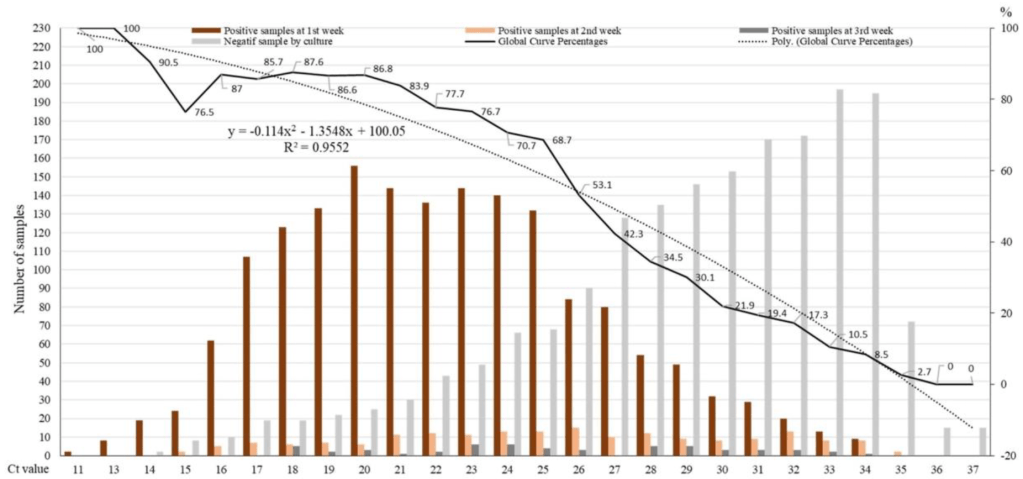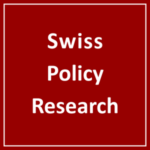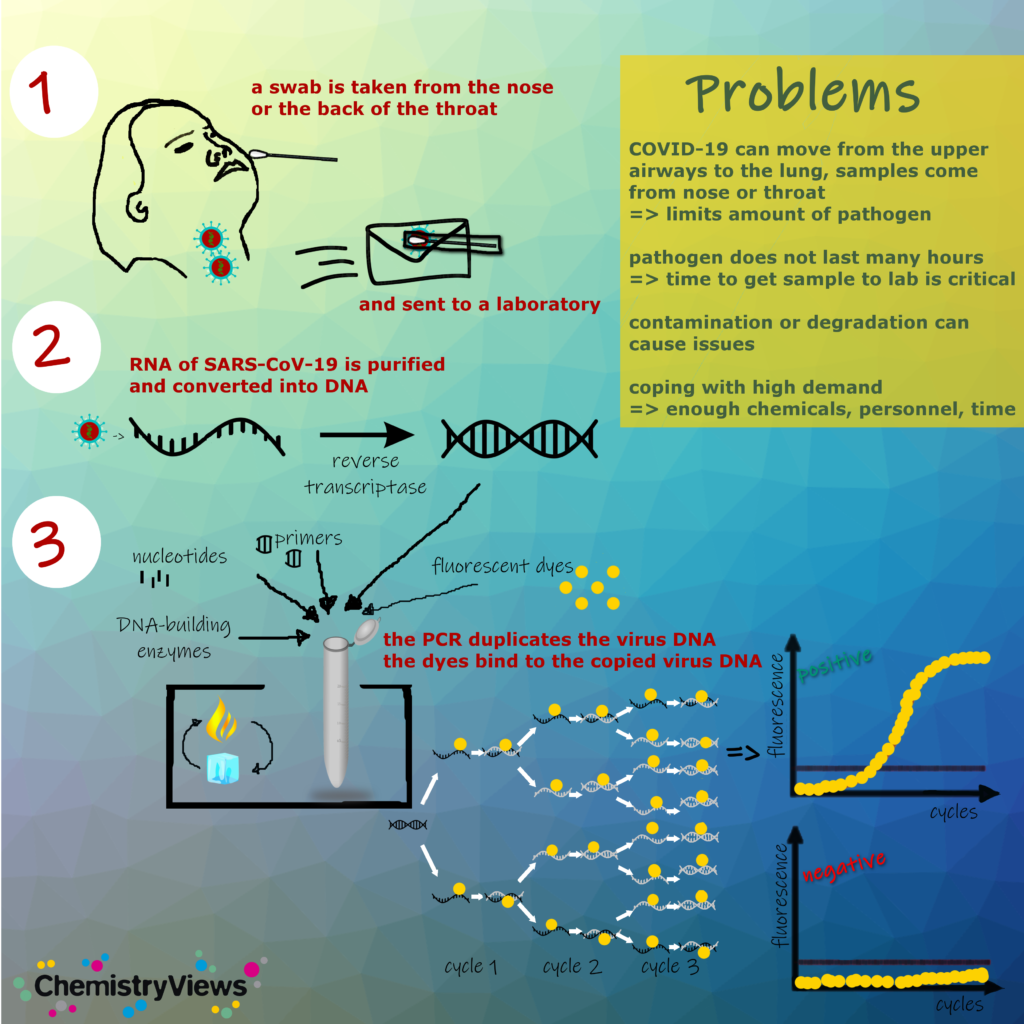The Trouble with PCR Tests
DEBATES ON COVID - VACCINES, 5 Oct 2020
Swiss Policy Research - TRANSCEND Media Service

PCR cycle threshold (11-37) and positive cell culture (black line, 100% to 0%) (Jafaar/Raoult)
4 Oct 2020 – Already in mid-March, SPR explained that the highly sensitive PCR tests are prone to producing false-positive results and their individual predictive value may easily drop below 50%.
The issues with PCR tests are numerous:
- There can be large-scale test kit contamination, as both the US and the UK (and several African countries) discovered during the early phase of the pandemic.
- There can be testing site or lab contamination, which has led to countless false positive results, school closures, nursing home quarantines, canceled sports events, and more.
- The PCR test can react to other coronaviruses. According to lab examinations, this happens in about 1 to 3% of cases if only one target gene is tested, as is the case in many (but not all) labs and as the WHO itself has recommended to avoid ambiguous positive/negative test results.
- The PCR test can detect non-infectious virus fragments weeks after an active infection, or from an infection of a contact person, as the US CDC confirmed.
- The PCR test can detect viable virus in quantities too small to be infectious (see below).
If the virus is not widespread in a population, and there is no test kit or lab contamination, and labs test for at least two target genes, the risk of a false-positive result is low. This is why, for instance, New Zealand at times had no positive PCR tests for weeks despite frequent testing.
But if there is an ongoing infection wave, or if there has been a recent infection wave, or if labs test only for one gene sequence or struggle with contamination, things get more complicated.
A PCR test is amplifying samples through repetitive cycles. The lower the virus concentration in the sample, the more cycles are needed to achieve a positive result. Many US labs work with 37 to 40 cycles, while many European labs work with 30 to 40 cycles.
The research group of French professor Didier Raoult has recently shown that at a cycle threshold (ct) of 25, about 70% of samples remained positive in cell culture (i.e. were infectious); at a ct of 30, 20% of samples remained positive; at a ct of 35, 3% of samples remained positive; and at a ct above 35, no sample remained positive (infectious) in cell culture (see diagram above).
This means that if a person gets a “positive” PCR test result at a cycle threshold of 35 or higher (as applied in most US labs and many European labs), the chance that the person is infectious is less than 3%. The chance that the person received a “false positive” result is 97% or higher.
(Note that the exact figures depend on the test and lab in question, and that if a sample was already positive at a lower cycle threshold (e.g. 20), chances of infectiousness are much higher.)
Juliet Morrison, a virologist at the University of California, Riverside, explained to the New York Times: “Any test with a cycle threshold above 35 is too sensitive. I’m shocked that people would think that 40 could represent a positive. A more reasonable cutoff would be 30 to 35.”
On the other hand, a negative result at a cycle threshold above 35 still does not exclude a covid infection, due to the problem of false negatives (e.g. sample taken improperly or too early). More recently, US researchers found that single-gene tests were false-negative due to new mutations.
The above considerations are valid at the individual level. At the aggregate level, if the adjusted number of positive PCR tests is suddenly increasing, this certainly indicates an infection wave. The problem then is that in many places, PCR testing has been catching at most 10% of all infections.
In conclusion, while PCR tests at high-risk places like hospitals, nursing homes and other sensitive locations are vital and undisputed, the benefit of mass PCR testing in the general population, which is costing mid-sized countries billions, may be somewhat more debatable.
See also: Are you infectious if you have a positive PCR test result for COVID-19? (Oxford CEBM)
See also
__________________________________________
 Swiss Policy Research, founded in 2016, is an independent, nonpartisan and nonprofit research group investigating geopolitical propaganda in Swiss and international media. SPR is composed of independent academics that for personal and professional reasons prefer to protect their identities, and receives no external funding; there are no financial sponsors or backers. Our articles have been published or shared by numerous independent media outlets and journalists, among them Julian Assange, and have been translated into more than two dozen languages.
Swiss Policy Research, founded in 2016, is an independent, nonpartisan and nonprofit research group investigating geopolitical propaganda in Swiss and international media. SPR is composed of independent academics that for personal and professional reasons prefer to protect their identities, and receives no external funding; there are no financial sponsors or backers. Our articles have been published or shared by numerous independent media outlets and journalists, among them Julian Assange, and have been translated into more than two dozen languages.
Tags: Airborne contagion, COVID-19, China, Community, Compassion, Coronavirus, Cuba, Economy, Empathy, Environment, Health, Lockdown, Orthomolecular Medicine, PCR Tests, Pandemic, Public Health, Research, Science, Science and Medicine, Swiss Policy Research, United Nations, WHO
DISCLAIMER: The statements, views and opinions expressed in pieces republished here are solely those of the authors and do not necessarily represent those of TMS. In accordance with title 17 U.S.C. section 107, this material is distributed without profit to those who have expressed a prior interest in receiving the included information for research and educational purposes. TMS has no affiliation whatsoever with the originator of this article nor is TMS endorsed or sponsored by the originator. “GO TO ORIGINAL” links are provided as a convenience to our readers and allow for verification of authenticity. However, as originating pages are often updated by their originating host sites, the versions posted may not match the versions our readers view when clicking the “GO TO ORIGINAL” links. This site contains copyrighted material the use of which has not always been specifically authorized by the copyright owner. We are making such material available in our efforts to advance understanding of environmental, political, human rights, economic, democracy, scientific, and social justice issues, etc. We believe this constitutes a ‘fair use’ of any such copyrighted material as provided for in section 107 of the US Copyright Law. In accordance with Title 17 U.S.C. Section 107, the material on this site is distributed without profit to those who have expressed a prior interest in receiving the included information for research and educational purposes. For more information go to: http://www.law.cornell.edu/uscode/17/107.shtml. If you wish to use copyrighted material from this site for purposes of your own that go beyond ‘fair use’, you must obtain permission from the copyright owner.
Read more
Click here to go to the current weekly digest or pick another article:
DEBATES ON COVID - VACCINES:
